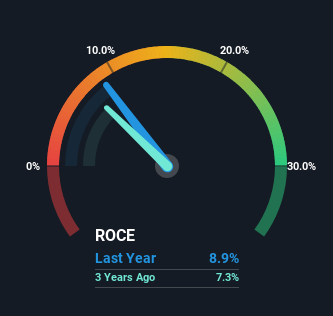- China
- /
- Medical Equipment
- /
- SHSE:600587
Shinva Medical InstrumentLtd's (SHSE:600587) Returns On Capital Not Reflecting Well On The Business

To find a multi-bagger stock, what are the underlying trends we should look for in a business? Firstly, we'll want to see a proven return on capital employed (ROCE) that is increasing, and secondly, an expanding base of capital employed. This shows us that it's a compounding machine, able to continually reinvest its earnings back into the business and generate higher returns. In light of that, when we looked at Shinva Medical InstrumentLtd (SHSE:600587) and its ROCE trend, we weren't exactly thrilled.
What Is Return On Capital Employed (ROCE)?
If you haven't worked with ROCE before, it measures the 'return' (pre-tax profit) a company generates from capital employed in its business. Analysts use this formula to calculate it for Shinva Medical InstrumentLtd:
Return on Capital Employed = Earnings Before Interest and Tax (EBIT) ÷ (Total Assets - Current Liabilities)
0.089 = CN¥708m ÷ (CN¥14b - CN¥6.5b) (Based on the trailing twelve months to September 2023).
Therefore, Shinva Medical InstrumentLtd has an ROCE of 8.9%. Even though it's in line with the industry average of 9.1%, it's still a low return by itself.
Check out our latest analysis for Shinva Medical InstrumentLtd

In the above chart we have measured Shinva Medical InstrumentLtd's prior ROCE against its prior performance, but the future is arguably more important. If you're interested, you can view the analysts predictions in our free analyst report for Shinva Medical InstrumentLtd .
What The Trend Of ROCE Can Tell Us
When we looked at the ROCE trend at Shinva Medical InstrumentLtd, we didn't gain much confidence. To be more specific, ROCE has fallen from 12% over the last five years. However, given capital employed and revenue have both increased it appears that the business is currently pursuing growth, at the consequence of short term returns. And if the increased capital generates additional returns, the business, and thus shareholders, will benefit in the long run.
On a related note, Shinva Medical InstrumentLtd has decreased its current liabilities to 45% of total assets. That could partly explain why the ROCE has dropped. Effectively this means their suppliers or short-term creditors are funding less of the business, which reduces some elements of risk. Since the business is basically funding more of its operations with it's own money, you could argue this has made the business less efficient at generating ROCE. Either way, they're still at a pretty high level, so we'd like to see them fall further if possible.
The Key Takeaway
Even though returns on capital have fallen in the short term, we find it promising that revenue and capital employed have both increased for Shinva Medical InstrumentLtd. And the stock has followed suit returning a meaningful 49% to shareholders over the last five years. So while the underlying trends could already be accounted for by investors, we still think this stock is worth looking into further.
If you want to continue researching Shinva Medical InstrumentLtd, you might be interested to know about the 1 warning sign that our analysis has discovered.
While Shinva Medical InstrumentLtd may not currently earn the highest returns, we've compiled a list of companies that currently earn more than 25% return on equity. Check out this free list here.
New: Manage All Your Stock Portfolios in One Place
We've created the ultimate portfolio companion for stock investors, and it's free.
• Connect an unlimited number of Portfolios and see your total in one currency
• Be alerted to new Warning Signs or Risks via email or mobile
• Track the Fair Value of your stocks
Have feedback on this article? Concerned about the content? Get in touch with us directly. Alternatively, email editorial-team (at) simplywallst.com.
This article by Simply Wall St is general in nature. We provide commentary based on historical data and analyst forecasts only using an unbiased methodology and our articles are not intended to be financial advice. It does not constitute a recommendation to buy or sell any stock, and does not take account of your objectives, or your financial situation. We aim to bring you long-term focused analysis driven by fundamental data. Note that our analysis may not factor in the latest price-sensitive company announcements or qualitative material. Simply Wall St has no position in any stocks mentioned.
About SHSE:600587
Shinva Medical InstrumentLtd
Provides medical devices, pharmaceutical equipment, medical services, and medical trade in the People’s Republic of China.
Flawless balance sheet and fair value.
Market Insights
Community Narratives



